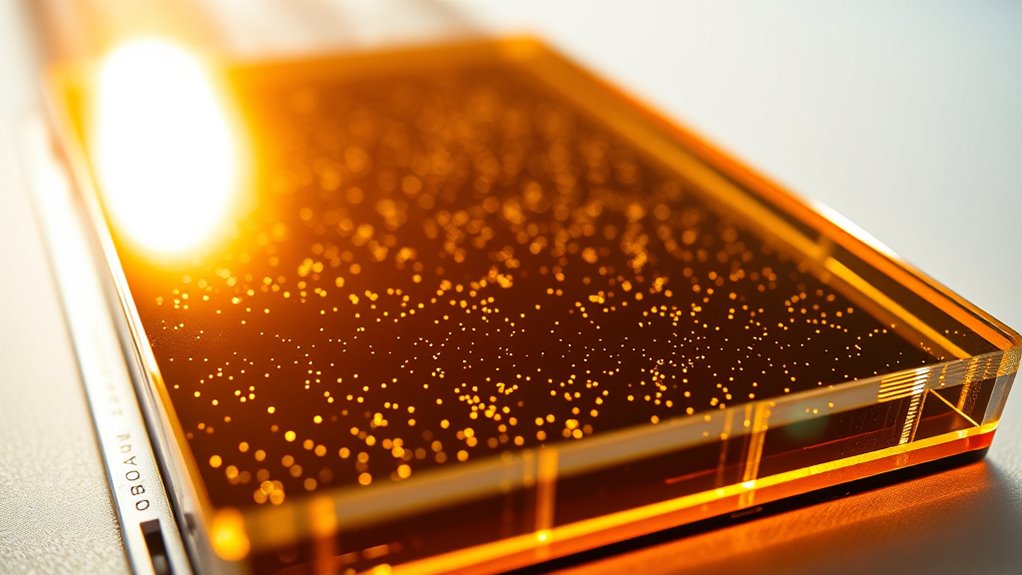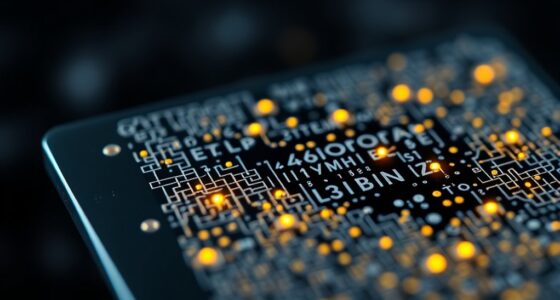Nanoparticle doping in perovskite solar cells involves adding nanoparticles like quantum dots or metal oxides to improve light absorption, charge transport, and device stability. These particles help manage optical properties, reduce recombination, and reinforce the structure. Incorporating nanoparticles through various methods enhances performance while maintaining durability. Although challenges exist, recent advances show promising results. Continue exploring to discover how these strategies are shaping high-efficiency, long-lasting solar technologies.
Key Takeaways
- Nanoparticle doping enhances charge transport, reduces recombination, and improves stability in perovskite solar cells.
- Incorporating nanoparticles like quantum dots and metal oxides broadens light absorption and boosts efficiency.
- Solution-based and layer-by-layer methods allow controlled incorporation of nanoparticles into perovskite layers.
- Doping with nanoparticles passivates defects and reinforces structural integrity, increasing device durability.
- Advances in nanoparticle synthesis and characterization enable tailored properties for optimized solar cell performance.
The Role of Nanoparticles in Enhancing Perovskite Properties
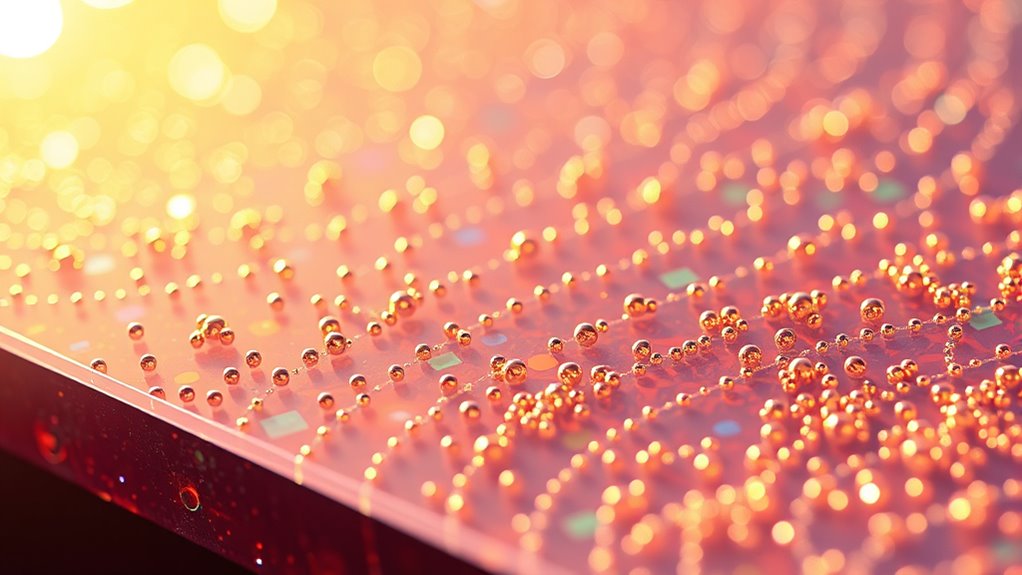
Nanoparticles play a pivotal role in improving the performance of perovskite solar cells by modifying their structural and electronic properties. This enhancement can lead to more environmentally friendly solutions by increasing efficiency and reducing waste. Using nanoparticles often results in materials that are more stable and durable, lowering the need for frequent replacements and minimizing environmental impact. Additionally, nanoparticle doping can improve cost effectiveness by reducing manufacturing costs through better material utilization and simpler processing techniques. These improvements make the technology more accessible and sustainable, addressing key concerns about environmental footprint and affordability. By optimizing the perovskite layer, nanoparticles contribute to cleaner energy production while ensuring the economic viability of solar cell deployment. Furthermore, understanding the material stability of these nanoparticles is crucial for long-term performance.]
Types of Nanoparticles Used in Doping Perovskite Layers
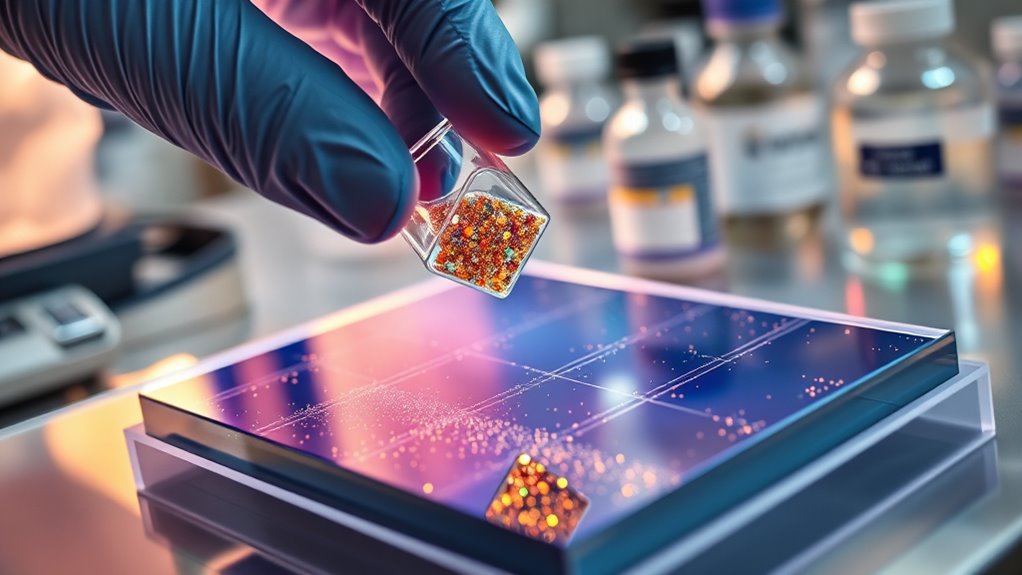
To effectively dope perovskite layers, researchers utilize a variety of nanoparticles, each chosen for their unique properties. Quantum dots and metal oxides are common options. Quantum dots improve charge transport and stability due to their tunable bandgap, while metal oxides like TiO₂ and ZnO enhance electron extraction and reduce recombination. These nanoparticles can be tailored to optimize device performance. Consider the table below, which highlights key features of these nanoparticles:
| Nanoparticle Type | Key Properties | Main Benefits |
|---|---|---|
| Quantum Dots | Tunable bandgap, size-dependent | Improved charge separation |
| Metal Oxides | High conductivity, stability | Better electron transfer |
| Ceramics | Good chemical stability | Enhanced durability |
Choosing the right nanoparticle depends on your specific device needs and desired performance enhancements. Additionally, understanding the material properties of nanoparticles can further inform their optimal application in perovskite solar cells.
Methods for Incorporating Nanoparticles Into Perovskite Films
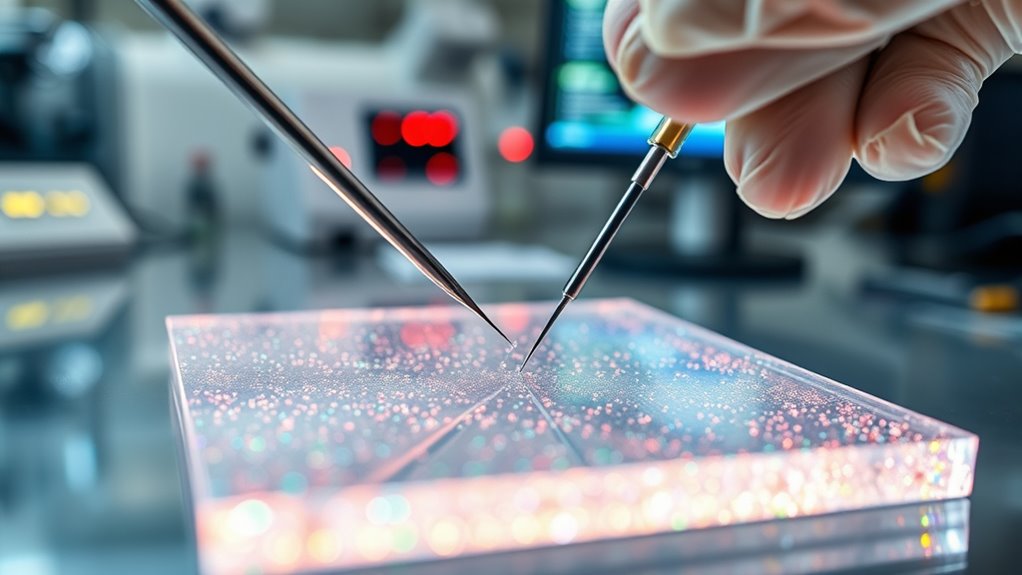
You can incorporate nanoparticles into perovskite films using various solution-based deposition methods. Optimizing spin coating parameters helps achieve uniform nanoparticle distribution, improving device performance. Layer-by-layer assembly offers precise control over nanoparticle placement within the film structure.
Solution-Based Deposition Techniques
Solution-based deposition techniques are widely employed to incorporate nanoparticles into perovskite films efficiently. You can use methods like spin coating, doctor blading, or slot-die coating to deposit nanoparticle suspensions directly onto substrates. During nanoparticle synthesis, controlling parameters like size and surface chemistry guarantees quantum confinement effects, which enhance optoelectronic properties. These techniques allow uniform dispersion of nanoparticles within the perovskite precursor solution, promoting seamless integration. You can tailor the concentration of nanoparticles to optimize charge transport and stability without disrupting film formation. By adjusting processing conditions, you ensure that nanoparticles are evenly distributed throughout the film, improving device performance. Overall, solution-based methods offer a scalable, versatile approach for doping perovskite layers with carefully synthesized nanoparticles.
Spin Coating Optimization
Optimizing spin coating parameters is essential for effectively incorporating nanoparticles into perovskite films. You should focus on adjusting speed, acceleration, and solution viscosity to achieve uniform nanoparticle distribution. Surface modification of nanoparticles can improve their compatibility with the perovskite precursor, enhancing film quality and reducing defects. By fine-tuning these parameters, you can minimize waste and material use, leading to cost reduction. Proper surface treatment guarantees better adhesion and dispersion, which simplifies the coating process. Using optimized spin speeds and durations prevents nanoparticle agglomeration and uneven layers. This approach streamlines fabrication, improves film stability, and lowers overall production costs. In sum, careful control of spin coating conditions and surface modifications enhances nanoparticle integration, boosting device performance while keeping manufacturing economical.
Layer-by-Layer Assembly
Layer-by-layer (LbL) assembly offers a precise and versatile approach for incorporating nanoparticles into perovskite films. You can control nanoparticle placement and density by alternating layers, enabling tailored interfaces. During nanoparticle synthesis, you select materials that exhibit quantum confinement effects, which enhance optoelectronic properties. Using LbL, you deposit positively and negatively charged layers, trapping nanoparticles within the perovskite matrix and improving charge transfer. This method minimizes defects and promotes uniform distribution, leading to better stability and efficiency. By adjusting parameters such as layer thickness and deposition time, you optimize the doping process. LbL assembly’s precision allows you to incorporate nanoparticles with specific sizes and compositions, harnessing quantum confinement to boost performance in perovskite solar cells.
Impact of Nanoparticle Doping on Light Absorption and Optical Properties
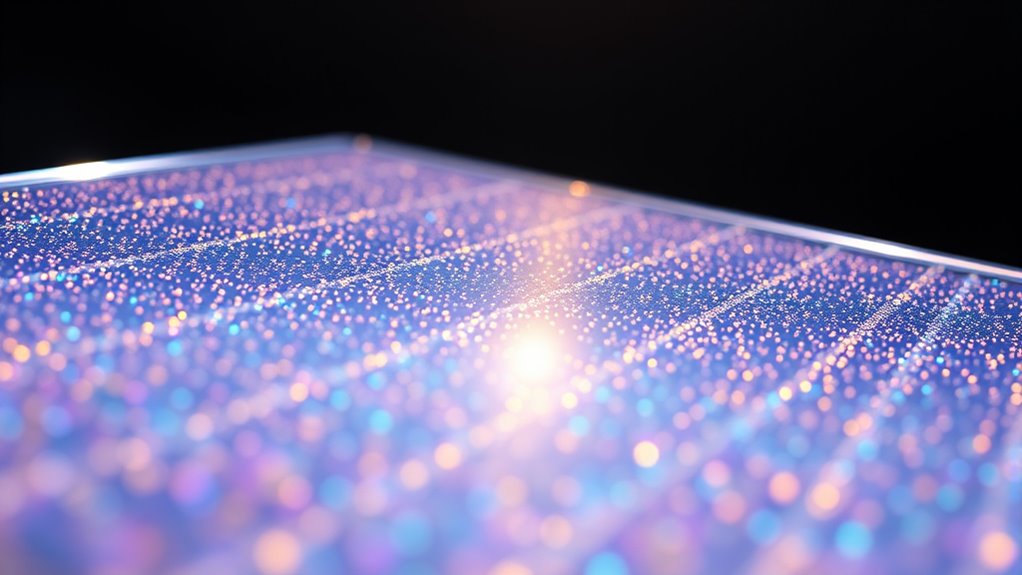
Nanoparticle doping can markedly boost the light absorption capabilities of perovskite solar cells. By introducing different nanoparticles, you can tailor the optical properties to capture more sunlight effectively. This approach allows for enhanced light harvesting and tunable absorption spectra, improving overall device performance. Additionally, selecting appropriate nanoparticles can help reduce recombination losses and improve stability under operational conditions material compatibility.
Enhanced Light Harvesting
Doping perovskite solar cells with nanoparticles substantially enhances their light absorption capabilities. Quantum dots increase absorption across a broader spectrum, while plasmonic effects amplify local electromagnetic fields, boosting efficiency. These nanoparticles scatter and trap light more effectively, leading to better light harvesting. The table below summarizes how different nanoparticles improve optical properties:
| Nanoparticle Type | Effect on Light Absorption | Key Feature |
|---|---|---|
| Quantum dots | Broader spectral absorption | Size-tunable properties |
| Plasmonic nanoparticles | Enhanced local fields | Surface plasmon resonance |
| Metal oxides | Increased scattering | High stability |
| Dielectric particles | Light trapping | Low loss |
Tunable Optical Absorption
By incorporating different nanoparticles into perovskite materials, you can finely tune the absorption spectrum to improve solar cell efficiency. Quantum confinement effects in nanoparticles allow you to adjust the bandgap, shifting absorption toward desired wavelengths. Surface modification of nanoparticles further enhances optical properties by reducing surface defects and optimizing light interaction. This tailoring enables you to extend absorption into broader spectral regions, capturing more sunlight. Doping with nanoparticles also introduces localized energy states, which can enhance exciton generation and improve charge transfer. Together, quantum confinement and surface modification provide a versatile approach to achieving tunable optical absorption, making your perovskite solar cells more responsive across the solar spectrum and boosting overall performance.
Improving Charge Transport and Recombination Dynamics
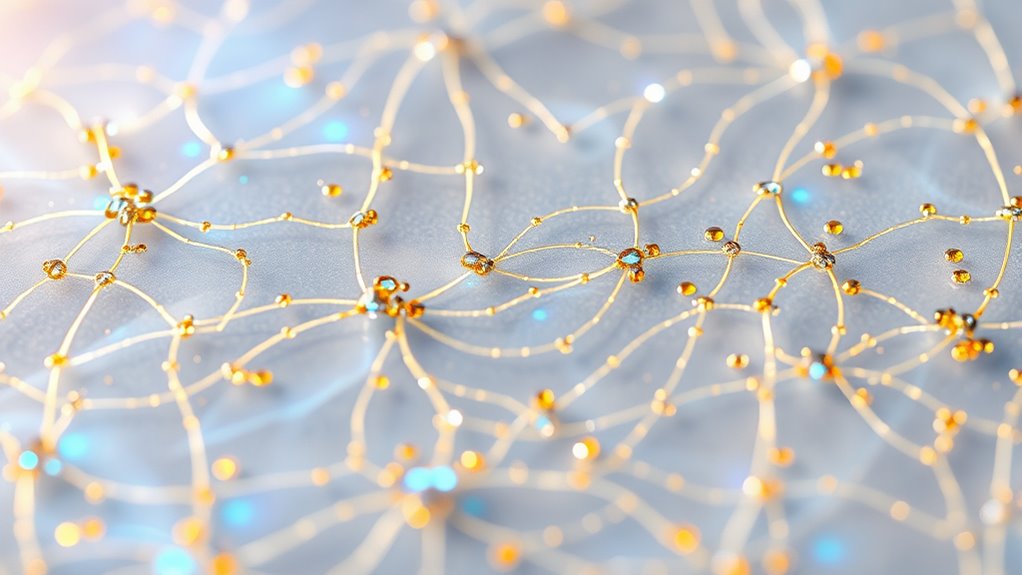
Enhancing charge transport and reducing recombination losses are crucial steps toward improving the efficiency of perovskite solar cells. You can achieve this through effective perovskite crystal engineering, optimizing how the crystals form and grow. Incorporating nanoparticles via advanced synthesis methods creates pathways that facilitate charge movement and minimizes trap states where recombination occurs. These nanoparticles can passivate defects at grain boundaries and interfaces, leading to smoother charge flow. By tailoring the size, morphology, and dispersion of nanoparticles, you improve charge carrier mobility and lifetime. This results in lower recombination rates and enhanced photovoltaic performance. Carefully controlling the nanoparticle synthesis methods allows you to fine-tune these effects, making the perovskite layer more conductive and reducing energy losses during operation. Sound design techniques such as layering and manipulation can be metaphorically applied to optimize the arrangement of nanoparticles for better charge flow.
Effects of Nanoparticle Doping on Device Stability and Durability
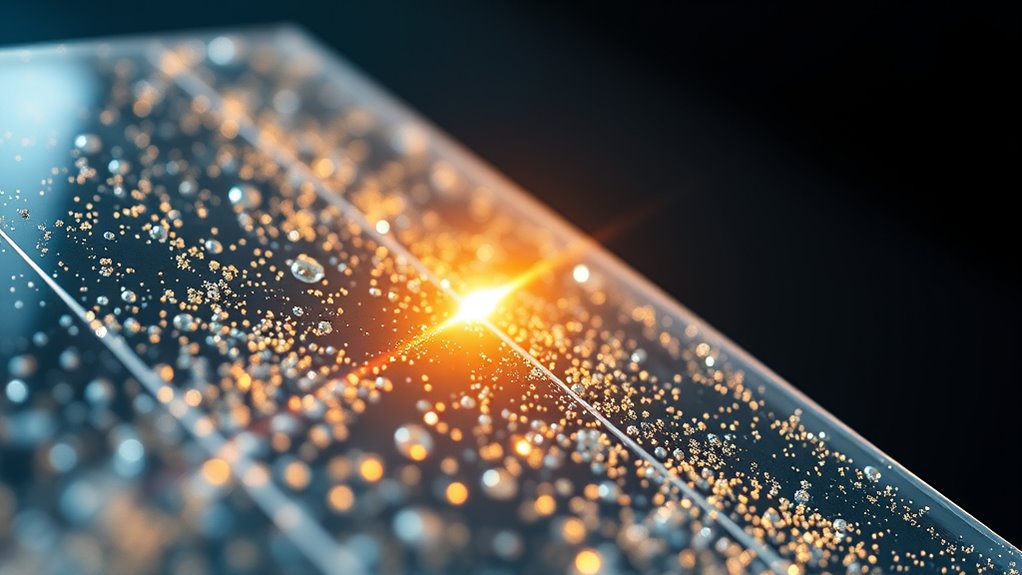
Nanoparticle doping plays a pivotal role in improving the stability and durability of perovskite solar cells. By enhancing the structural integrity and passivating defect sites, nanoparticles help resist environmental factors like moisture, heat, and UV exposure, extending device lifespan. This improvement reduces the frequency of replacements, positively impacting the environmental impact by lowering waste and resource consumption. Additionally, nanoparticle doping can make fabrication processes more economically feasible by decreasing the need for costly encapsulation and stabilization methods. You’ll find that stable devices maintain high efficiency over longer periods, making large-scale deployment more practical. Overall, nanoparticle doping not only boosts device longevity but also supports sustainable development by addressing environmental and economic challenges in solar technology. Incorporating environmental resilience into material design further ensures long-term performance and sustainability.
Challenges and Limitations of Nanoparticle Doping Strategies

Despite the promising benefits of nanoparticle doping in perovskite solar cells, several challenges hinder its widespread adoption. Scalability issues make it difficult to produce uniform, large-scale devices with consistent nanoparticle distribution. You may also face environmental concerns related to nanoparticle synthesis and disposal, which pose risks to ecosystems and human health. Achieving precise control over nanoparticle size, concentration, and placement remains complex, impacting device performance and reproducibility. Compatibility with existing fabrication processes can be problematic, potentially increasing manufacturing costs. Additionally, long-term stability concerns arise from potential nanoparticle aggregation or migration, further complicating commercialization efforts. Moreover, the material stability of perovskite layers can be compromised by nanoparticle integration, affecting device longevity. Overall, these limitations require innovative solutions to make nanoparticle doping a practical, sustainable strategy for advancing perovskite solar technology.
Recent Advances and Innovative Approaches in Nanoparticle Doping
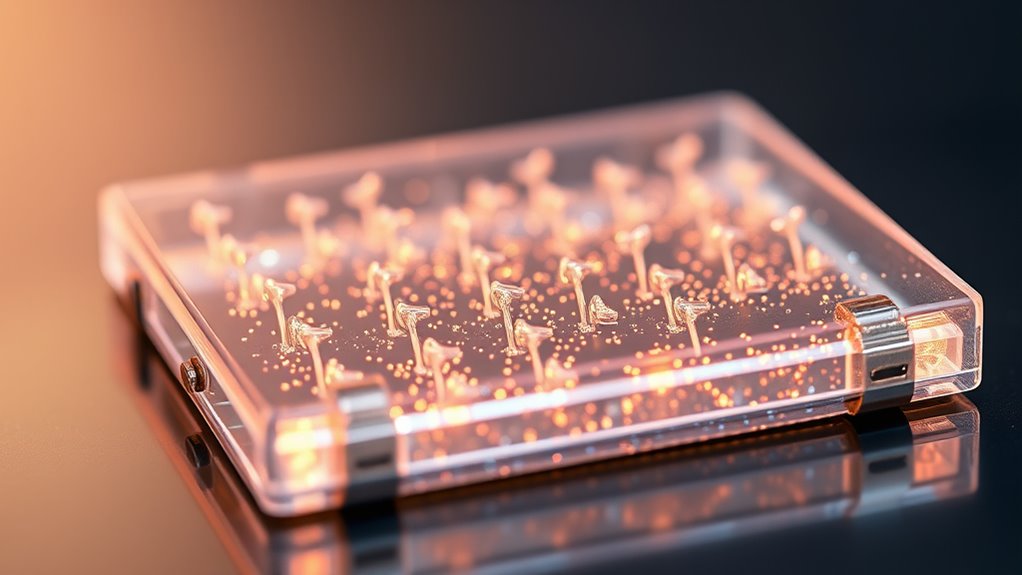
Recent advances in nanoparticle doping have remarkably improved charge transport and stability in perovskite solar cells. Innovative approaches use tailored nanoparticles to enhance device performance and longevity. These developments open new pathways for more efficient and durable solar energy solutions. Glycolic acid has also been explored in related research for its potential to improve material processing and surface properties.
Enhanced Charge Transport
Advances in nanoparticle doping have considerably improved charge transport in perovskite solar cells by enhancing the pathways for electron and hole movement. You benefit from the tailored electronic properties of nanoparticles, where quantum confinement effects can increase charge carrier mobility. Innovative nanoparticle synthesis methods enable precise control over size and composition, maximizing their role as charge facilitators. These approaches reduce recombination losses and improve overall efficiency. Researchers are exploring how different nanoparticle architectures influence charge flow, leading to more efficient devices. By integrating dopants with specific quantum confinement characteristics, you can fine-tune energy levels for better charge extraction. The combination of advanced synthesis techniques and understanding of quantum effects paves the way for more effective charge transport mechanisms in perovskite solar cells.
- Quantum confinement effects on charge mobility
- Precise nanoparticle synthesis techniques
- Tailoring energy levels for ideal charge extraction
- Reducing recombination losses through doping
- Nanoparticle architecture influencing charge pathways
Stability Improvements
Building on improvements in charge transport, researchers are now focusing on enhancing the long-term stability of perovskite solar cells through innovative nanoparticle doping strategies. These approaches aim to reduce degradation caused by moisture, heat, and UV exposure, which threaten cell longevity. By incorporating stable nanoparticles, you can improve the environmental impact of the devices, making them more eco-friendly and less prone to harmful breakdown products. Additionally, these strategies often lower overall costs by extending device lifespan and decreasing the need for frequent replacements. Recent advances include doping with inorganic nanoparticles that reinforce the perovskite structure and inhibit ion migration, leading to more robust performance. This focus on stability not only advances efficiency but also addresses economic and environmental considerations essential for commercial viability.
Characterization Techniques for Doped Perovskite Materials
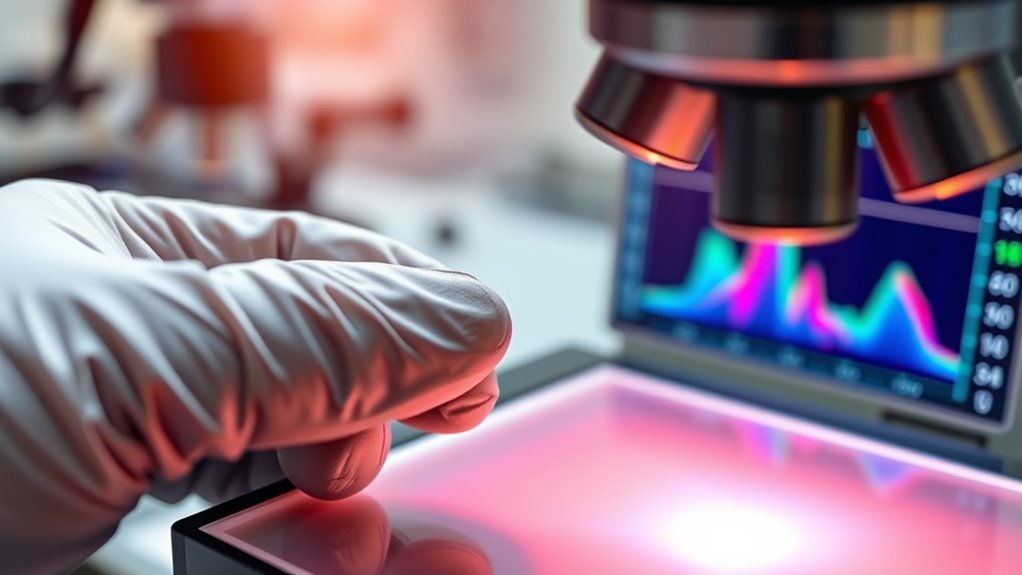
To thoroughly understand the effects of nanoparticle doping in perovskite materials, you need to employ a range of characterization techniques that reveal their structural, optical, and electronic properties. Techniques like X-ray diffraction (XRD) identify crystal phase changes, while UV-Vis spectroscopy assesses optical absorption shifts related to quantum dot integration. Electron microscopy provides insights into nanoparticle distribution, and photoluminescence (PL) reveals recombination dynamics influenced by magnetic nanoparticle effects. Additionally, techniques such as impedance spectroscopy can evaluate charge transport. Understanding magnetic nanoparticle effects and quantum dot integration requires combining these methods to analyze how doping alters material behavior, stability, and efficiency. These insights are essential to optimize doping strategies for enhanced perovskite performance. Advanced characterization methods are increasingly vital for comprehensive analysis of doped perovskite materials.
Future Perspectives and Potential Applications in Solar Technology
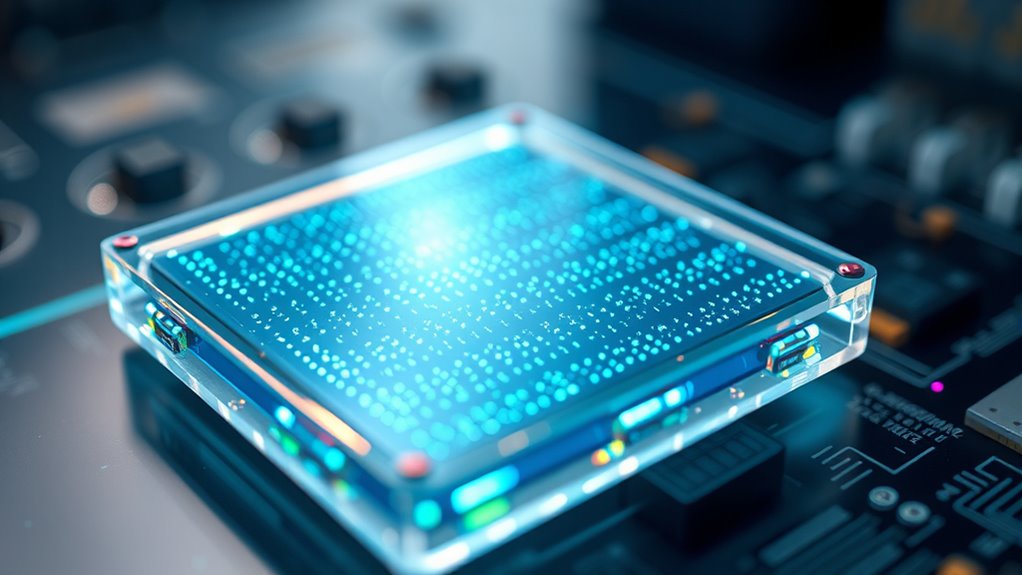
As research progresses, nanoparticle-doped perovskite solar cells are poised to revolutionize solar technology by offering higher efficiencies, improved stability, and tailored functionalities. Quantum dot integration can enhance light absorption and charge transfer, leading to more efficient energy conversion. Additionally, nanoparticle doping provides mechanical reinforcement, making these cells more durable and resistant to environmental stress. Future applications may include flexible, lightweight panels suitable for portable devices and building integration. The ability to tune optical and electronic properties opens doors for multifunctional solar panels with self-cleaning or sensing capabilities. As you explore these advancements, consider how combining quantum dot integration with mechanical reinforcement could *release* new potentials, ultimately making perovskite-based solar technology more viable and widespread. Furthermore, advancements in solar cell efficiency and material stability are crucial for the commercial viability of these innovative photovoltaic systems.
Frequently Asked Questions
How Does Nanoparticle Doping Influence Perovskite Crystal Growth Mechanisms?
You influence crystal growth by introducing nanoparticles that act as nucleation sites, promoting controlled crystal nucleation. This accelerates grain formation and results in larger, more uniform grains. Nanoparticle doping reduces grain boundary defects, enhancing charge transport. The particles help manage the growth process, leading to improved film quality and stability. Overall, nanoparticle doping optimizes the crystal growth mechanism, boosting the efficiency and durability of the solar cells.
What Environmental Impacts Are Associated With Nanoparticle Synthesis for Solar Cell Doping?
Think of nanoparticle synthesis like baking a cake—if you’re not careful, emissions from chemicals and energy use can spike, harming the environment. You might unknowingly release toxic gases or consume excessive energy during production, contributing to pollution and climate change. To minimize impacts, you should focus on greener methods, reduce emissions, and optimize energy efficiency, ensuring your solar technology benefits the environment rather than burdens it.
Can Nanoparticle Doping Be Integrated With Other Perovskite Enhancement Techniques?
Yes, you can integrate nanoparticle doping with other perovskite enhancement techniques to boost energy harvesting. By creating hybrid interfaces, you improve charge transfer and stability, leading to higher efficiency. Combining nanoparticle doping with methods like surface passivation or compositional engineering can optimize the perovskite’s optoelectronic properties. This synergy results in more robust, high-performing solar cells, advancing energy harvesting technologies effectively.
What Are the Long-Term Effects of Nanoparticle Doping on Device Recyclability?
You might face recycling challenges with nanoparticle doping, as it can impact device longevity and complicate material separation. Over time, nanoparticles could degrade or leach, reducing efficiency and making recycling more difficult. While doping can enhance performance initially, long-term effects may include increased waste or limited recyclability. Careful design and material selection are essential to balance device longevity with sustainable recycling practices.
How Does Nanoparticle Size Distribution Affect Doping Efficiency and Device Performance?
Ever wondered how tiny variations can make a big difference? Smaller, uniform nanoparticles improve doping efficiency by ensuring consistent size distribution, which enhances doping consistency across the perovskite layer. This uniformity leads to better charge transport, increased device performance, and fewer defects. When nanoparticles are too varied in size, doping becomes uneven, causing performance drops. So, maintaining size uniformity is key to enabling maximum device efficiency.
Conclusion
Think of nanoparticle doping as guiding a ship through stormy seas toward a brighter horizon. With each innovation, you steer closer to solar cells that are more efficient and resilient. While challenges remain, your efforts light the way, transforming the darkness of energy scarcity into a dawn of sustainable power. Keep steering this journey—your work is the beacon that will illuminate the future of clean energy for all.
